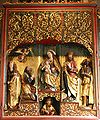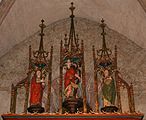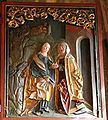Church of the Holy Cross, Saint Peter and Genovefa (Ellhofen)
The Church of the Holy Cross, Saint Peter and Genovefa is the Protestant parish church in Ellhofen . It belongs to the Protestant parish of Ellhofen in the church district of Weinsberg-Neuenstadt of the Evangelical Church in Württemberg and houses the Genovefa altar , an important carved altar from the 16th century.
history
A chapel in Ellhofen was first mentioned in 1303 as a branch of the Sülzbach parish church . Whether this chapel was already on the site of today's church is uncertain, but it is commonly assumed. With the donation of the patronage law of Sülzbacher church to the monastery Schöntal by Engelhard of vineyard located Engelhard retained the patronage right on the church Ellhofener expressly. On the occasion of this donation, the church saints of that time are also named: the holy cross, Peter, the holy innocents and Genoveva. In a certificate of indulgence from Bishop Albert von Würzburg from 1357, the chapel is first referred to as ecclesia (church). At that time, the church, looked after by a chaplain , was the destination of pilgrimages .
The core of today's building is a Romanesque choir tower church , the construction of which, according to the frescoes preserved in the tower choir, should have started around 1380 at the latest. In 1412 the Electoral Palatinate, together with half of the castle and town, also acquired the right of patronage over the church from the Lords of Weinsberg . According to a building inscription, the choir tower was completed in its current form in 1498. The late Gothic carved altar that is still preserved today was probably brought into the church in connection with this expansion.
In the Bavarian War of Succession in 1504, Ellhofen came to Württemberg with the rule of Weinsberg and was reformed from there in 1534 . After the dead from Ellhofen had originally been buried in Sülzbach, a separate cemetery was set up in Ellhofen in 1589/91. At that time the church separated from Sülzbach, and in future the church was looked after by the diaconate in Weinsberg.
The sacristy of the church was renewed in 1733, and after 1741 a comprehensive renovation of the church followed. Another major renovation took place in 1799. In 1837 the church was expanded and renovated in 1924/25 by the architect Wilhelm Hermann Jost . The vault painting discovered in the cross-vaulted choir of the east tower was only uncovered in 1960 by the Ulm restorer Walter Hammer. The church received its current exterior and interior design from partial demolition and expansion of the nave to the north and south using exposed concrete and flat roof construction, the addition of additional community rooms and a complete redesign of the church interior between 1971 and 1977.
architecture
In 1837 the traditionally longitudinally oriented church was extended to the south by adding a transept with the south wall removed and the interior designed as a transverse church . The building historian and architect Walther-Gerd Fleck (1926-2014), who was involved with the Kreuzkirche 140 years later, was predestined for this latest renovation and expansion task: from 1954 to 2011, three years before his death, he researched and published on burg-, schloss - Settlement and church building history issues and became a specialist architect for monument preservation. He paid particular attention to the typical Protestant transverse churches in Württemberg since 1562 ( Stuttgart Castle Church ), also in the countryside (e.g. 1602 Ev. Church of Öhringen- Ohrnberg ), which he began to prove and which theologically and architecturally included in the history of the church. His commission from Ellhofen to expand the nave, which was only designed as a transverse church in 1837, allowed him to adopt and reinterpret this basically proven and, moreover, only genuinely Protestant church structure. He referred explicitly to the Stuttgart Castle Church in 1562: "The transverse church space has become a tried and tested basic form of Protestant church construction since Duke Christoph's castle church of 1562" and "The transverse space has become a form for the Protestant preaching church compared to the pre-Reformation longitudinal space since the im The castle church in the old castle in Stuttgart, inaugurated in 1562, was so well proven in numerous subsequent buildings spread all over Germany that there was every reason to use the solution offered by the situation here ”. By demolishing the north wall and adding two flat-roofed exposed concrete “wings”, he widened the nave to the north and south to form a rectangular church space without a gallery. The alignment of the rows of pews in two diagonal blocks on the liturgical center (pulpit and altar) was largely based on the church building principles of the Wiesbaden program . The west gable wall was renovated and preserved.
Furnishing
Genovefa altar
In the church there is a late Gothic winged altar from around 1515, which is attributed to Hans Seyfer's surroundings and shows the adoration of the kings as fully plastic carved figures in the center . On the inner wings, the Annunciation to Mary and the Visitation of the Virgin Mary can be seen in the upper halves , the Nativity and the Circumcision of the Lord in the lower halves as relief carvings.
The outside of the wings are painted. The birth of the Son of God is shown at the top left and the adoration by the Magi ( Epiphany ) at the top right . The two lower paintings show images from the life of Saint Genoveva: At the bottom left Genoveva awakens a child who drowned in the well. At the bottom right you can see how she heals the blind and the mobility impaired and frees others from leprosy and plague .
The predella shows Christ as the Man of Sorrows between his mother and John the Evangelist, each as plastic half-figures. In the altar extension there are sculptural figures of St. Christopher, St. Barbara, and St. Genoveva, each in niches crowned by cracks.
In the center of the middle shrine is the adoration of the Magi . Maria sits in the middle and holds her son on her knee with her right hand. In her left hand she carries a treasure chest, a gift from the king who kneels on her right. To her left are the other two kings, equipped with a censer and an olifant. On the far left of the shrine is a woman who mistakenly received a sword during the last restoration and is therefore identified as Katharina. Due to the position of her body and hands, however, she is to be understood as a Genoveva who originally carried a candle in her right hand. Below Mary, in a kind of divided central compartment, the prophet Isaiah can be seen, who carries a ribbon in his right hand and points to it with his left hand. On this tape you can read a quote from him: “He is wounded for our iniquity and bruised for our sin. The punishment rests on him so that we may have peace and through his wounds we are healed ” ( Isa 53,5 EU ).
In the division of the middle shrine into an ensemble of figures enthroned on stair-like plinths, the altar stylistically resembles the Cyriakus Church in Bönnigheim . The middle compartment of the shrine altar was divided again in both churches. In the lower middle compartment of the altar in Bönnigheim is the namesake of the church. In Ellhofen, the prophet Isaiah is in the lower middle compartment .
The center shrine shows the adoration of the Magi
The predella shows Mary, the Son of God and John
Circumcision of Jesus Christ ( Brit Mila )
Frescoes in the choir vault
In addition to painting remains on the north wall of the nave, which were no longer interpretable in the mid-1970s, there is a selection of essential scenes from New Testament salvation history in the four vaults of the existing tower choir: from the birth of Jesus to the Apocalypse with the risen Lord as judge of the world. Stylistically, they can be dated to around 1380.
Pulpit and font
The baptismal font is clearly marked with the year 1677 and a donor inscription. The pulpit , which is stylistically reminiscent of the Baroque and was re-erected after a restoration in 1798 and given the later date, is likely to come from this period .
Apostle painting cycle
The 18 former gallery parapet paintings, a cycle of apostles, created from the end of the 17th to the second half of the 18th century, have been placed on the west wall since 1977 after the old galleries were removed. As representatives of the Old and New Covenants, Moses and Christ are arranged directly next to the entrance, the apostles with biblical quotations and their attributes to the left and right of it.
Art glazing
The Stuttgart-based glass painting workshop V. Saile created the abstract, ornamental lead glazing of the windows and the upper ribbon windows in the flat-roofed north and south extensions .
Bronze wall relief
The exposed concrete wall outside north of the west entrance bears a bronze sculpture by the sculptor Ingrid Seddig (1926–2008) from Korb / Remstal. It thematizes the words of Jesus “Come to me, everyone who is troublesome and burdensome; I want to refresh you ”( Mt 11:18 LUT ). The relief was inaugurated on December 4, 1982, Heilbronn's day of remembrance of the city's destruction in 1944. It was donated, among others, by the Heilbronn pastor Paul Pissowotzki (1911-2010), as well as the artist who comes from today's Poland.
Individual evidence
- ↑ Website of the Evangelical Church Community Ellhofen
- ^ Website of the Evangelical Church District Weinsberg-Neuenstadt
- ↑ Walther-Gerd-Fleck: Church of the Holy Cross, Saint Peter and Genovefa Ellhofen ; Ed. Ev. Parish Council Ellhofen; Ellhofen / Weinsberg 1981, pp. 20 and 23
- ^ Julius Fekete: Art and cultural monuments in the city and district of Heilbronn . 2nd Edition. Theiss, Stuttgart 2002, ISBN 3-8062-1662-2
- ↑ Hartmut Gräf: Unterländer Altars 1350-1540. An inventory . Städtische Museen Heilbronn, Heilbronn 1983 ( Heilbronner Museumsheft . No. 2). P. 45
- ↑ Ilse Rauschenberger: Three Neckar-Swabian carved retables of the late Gothic. Bönnigheim - Ellhofen - Neckargartach . City Museums Heilbronn, Heilbronn 1980 ( Heilbronner Museumhefte . No. 7)
- ↑ Fleck 1981, fig. 35.
- ↑ Article "Bronce Relief" ; in: Community letter of the Ev. Parish of Ellhofen; December 1982, back cover
literature
- Festschrift: Inauguration of the renewed and enlarged Church of the Holy Cross, Saint Peter and Genovefa in Ellhofen, August 21, 1977
- Walther-Gerd-Fleck: Church of the Holy Cross, Saint Peter and Genovefa Ellhofen ; Ed. Ev. Parish Council Ellhofen; Ellhofen / Weinsberg 1981
- Wolfram Angerbauer : Church conditions until 1900 , in: Ellhofen 1037 to 1987 , Ellhofen 1988, pp. 125-134.
- Hartmut Gräf: Unterländer Altars 1350–1540. An inventory . City Museums Heilbronn, Heilbronn 1983 ( Heilbronn Museum Booklet . No. 2)
Web links
Coordinates: 49 ° 8 ′ 49.2 ″ N , 9 ° 19 ′ 18.1 ″ E













